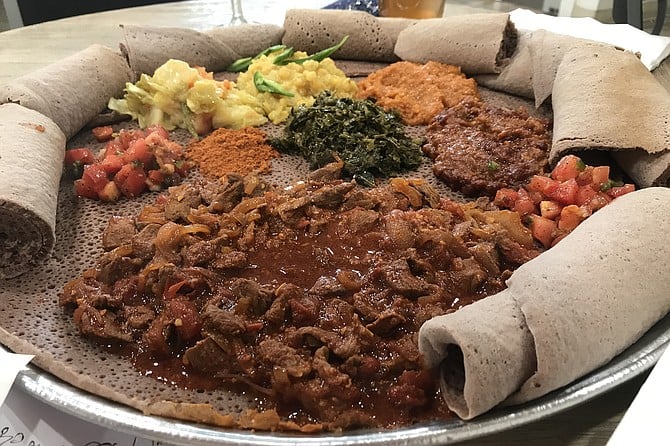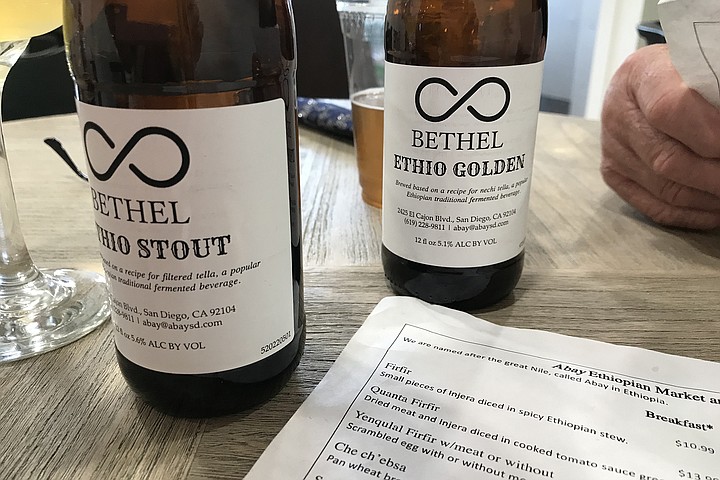 Facebook
Facebook
 X
X
 Instagram
Instagram
 TikTok
TikTok
 Youtube
Youtube

“Eee-yew! Spongey!” cries my buddy Tim. “And you have to eat with your fingers? A mess! Why can’t we have a knife and fork like at any other place?” He has just unrolled a section of slightly rubbery injera. This is the fermented bread that’s at the heart of all Ethiopian and Eritrean and Somali dishes. Injera looks like a soggy pizza, or a giant crumpet. “Out of my comfort zone, dude,” says Tim. “Didn’t I tell you? I’m strictly meat and potatoes.”
“Well, you might be surprised how close they are to this, bud,” I reply. Because I’ve already taken a couple of jumps into food from this part of the globe — the top-right side of Africa — and wanted to come back. I’m trying to get my buddy to discover the rest of the world through his gut. And part of the Ethiopian deal is that they use a lot of familiar vegetables like cabbage and spinach and yellow split peas, but treat them to Ethiopian flavorings. The stews themselves are interesting and usually intense. I discovered this in the backs of places that often looked modest in front, like grocery supply stores, but turned out to have rooms in the rear where they served incredible-tasting dishes. You might call this part of town Little Ethiopia. It’s on lower ECB (El Cajon Boulevard), near that famous flower place, Dave’s Flower Box. They have maybe half a dozen Ethiopian eateries scattered around here.
So we came in, and got led to the back by the owner, Faris. He sat us down near some stairs leading up to more space. “That is going to be our main dining room,” he said. “We’re growing! But it’s taking time.”

So here we are. Tonight we can start with — hey hey! — beer, and honey wine. And beer that’s made right here, by Faris. “Bethel Ethio Stout,” says the label on the bottle he’s brought me. It costs $4. “Brewed based on a recipe for filtered tella,” it says. Turns out tella is “a popular Ethiopian traditional fermented beverage,” a malt beer, looks like. Tim’s bottle is “Ethio Golden,” based on “nechi tella.” We both love our drinks. They’re tella with the addition of a hop-like Ethiopian herb, gesho. Not only this, but Faris opens a wine bottle and pours us each a champagne glassful. Oh mama. It turns out to be Ethiopian honey wine. Mead, rich and syrupy, sweet and yet not cloying.
Just to get things going foodwise, we order a couple of $2 sambusas, which are “baked or fried bread tossed in spiced butter, with vegetable or meat fillings.” We get one of each. Tim takes the baked one. I’m happy to chomp into the fried. Again, not hot-hot, but carrying a persistent spiciness (because, yes, we did ask for spicy), and a warm flavoring to the meat.

Choices start off with eggy breakfast dishes like firfir, which is small pieces of injera “diced in spicy Ethiopian stew.” Costs $10.99.
“I would go for the first dinner dish. It’s the most popular.” says Faris. He’s pointing to “Abay Special T’ibs (Chikina). It’s “tenderloin tips sautéed in onion and hot green pepper and cooked with Ethiopian spiced butter.” Hmm. Think I will. Even though it’s one of the more expensive dishes, at $16.99. (For a moment, I’m tempted by the meat combination dish of ye-beg siga wot (lamb stew), and ye siga wot (beef stew) ($15.99). “Sorry, that dish ran out,” says Faris. So, okay, t’ibs it is.
For some reason, Tim goes vegetarian. Actually, it’s a good choice, turns out: he gets a circus of split lentil, split peas, shiro (chickpea stew), cabbage, carrot, potato, and collard greens.
“You wanted meat and potatoes?” I ask.
“I want it to look like meat and potatoes,” he says, “but guess I’ll try it.”
Of course, we share it all. And the thing is, Tim’s veggies have been marinated with spiced butter and berbere sauce — a neat little red pyramid of it stands between the piles of veggies on the injera. Yes, it can be burning hot, but just eat it cautiously and taste how those flavors marinate in your mouth.

It’s the same with my plate. Both have the injera on the tray plus ripped rolls of it around the edge to eat with the feast of sautéed tenderloin tips. For me, specially with the gently sweet Ethiopian stout to drink, this is becoming a meal to remember, slightly lemony with the t’ibs, but rounded out with berbere richness. The spicy heat is warming and constant. It never gives up, maybe because it’s so complex. Berbere is a combination of 16 spices, including chili powder, fenugreek, ginger, garlic cardamom, cinnamon.
But I have to know something. “What does ‘Abay’ mean?” I ask Faris.
“‘Abay’ is our name for what you call the River Nile,” he says. “The Blue Nile starts in Ethiopia.”
Huh. I also have to know: “Is Ethiopian honey wine tej?”
“Yes,” says Faris. “It is our national drink.”
And, turns out, it is one of the oldest alcoholic drinks ever made. Someone was drinking this stuff 9000 years ago, a little before the first wines. I also learn that Ethiopia is probably the oldest Christian country in the world.
Tim and I box up our food to go. “Still got to get used to this injera stuff,” he says as he heads for his car, “but I’ll come back for that tej.”
“Next time,” I say, “leave your wheels behind.”


“Eee-yew! Spongey!” cries my buddy Tim. “And you have to eat with your fingers? A mess! Why can’t we have a knife and fork like at any other place?” He has just unrolled a section of slightly rubbery injera. This is the fermented bread that’s at the heart of all Ethiopian and Eritrean and Somali dishes. Injera looks like a soggy pizza, or a giant crumpet. “Out of my comfort zone, dude,” says Tim. “Didn’t I tell you? I’m strictly meat and potatoes.”
“Well, you might be surprised how close they are to this, bud,” I reply. Because I’ve already taken a couple of jumps into food from this part of the globe — the top-right side of Africa — and wanted to come back. I’m trying to get my buddy to discover the rest of the world through his gut. And part of the Ethiopian deal is that they use a lot of familiar vegetables like cabbage and spinach and yellow split peas, but treat them to Ethiopian flavorings. The stews themselves are interesting and usually intense. I discovered this in the backs of places that often looked modest in front, like grocery supply stores, but turned out to have rooms in the rear where they served incredible-tasting dishes. You might call this part of town Little Ethiopia. It’s on lower ECB (El Cajon Boulevard), near that famous flower place, Dave’s Flower Box. They have maybe half a dozen Ethiopian eateries scattered around here.
So we came in, and got led to the back by the owner, Faris. He sat us down near some stairs leading up to more space. “That is going to be our main dining room,” he said. “We’re growing! But it’s taking time.”

So here we are. Tonight we can start with — hey hey! — beer, and honey wine. And beer that’s made right here, by Faris. “Bethel Ethio Stout,” says the label on the bottle he’s brought me. It costs $4. “Brewed based on a recipe for filtered tella,” it says. Turns out tella is “a popular Ethiopian traditional fermented beverage,” a malt beer, looks like. Tim’s bottle is “Ethio Golden,” based on “nechi tella.” We both love our drinks. They’re tella with the addition of a hop-like Ethiopian herb, gesho. Not only this, but Faris opens a wine bottle and pours us each a champagne glassful. Oh mama. It turns out to be Ethiopian honey wine. Mead, rich and syrupy, sweet and yet not cloying.
Just to get things going foodwise, we order a couple of $2 sambusas, which are “baked or fried bread tossed in spiced butter, with vegetable or meat fillings.” We get one of each. Tim takes the baked one. I’m happy to chomp into the fried. Again, not hot-hot, but carrying a persistent spiciness (because, yes, we did ask for spicy), and a warm flavoring to the meat.

Choices start off with eggy breakfast dishes like firfir, which is small pieces of injera “diced in spicy Ethiopian stew.” Costs $10.99.
“I would go for the first dinner dish. It’s the most popular.” says Faris. He’s pointing to “Abay Special T’ibs (Chikina). It’s “tenderloin tips sautéed in onion and hot green pepper and cooked with Ethiopian spiced butter.” Hmm. Think I will. Even though it’s one of the more expensive dishes, at $16.99. (For a moment, I’m tempted by the meat combination dish of ye-beg siga wot (lamb stew), and ye siga wot (beef stew) ($15.99). “Sorry, that dish ran out,” says Faris. So, okay, t’ibs it is.
For some reason, Tim goes vegetarian. Actually, it’s a good choice, turns out: he gets a circus of split lentil, split peas, shiro (chickpea stew), cabbage, carrot, potato, and collard greens.
“You wanted meat and potatoes?” I ask.
“I want it to look like meat and potatoes,” he says, “but guess I’ll try it.”
Of course, we share it all. And the thing is, Tim’s veggies have been marinated with spiced butter and berbere sauce — a neat little red pyramid of it stands between the piles of veggies on the injera. Yes, it can be burning hot, but just eat it cautiously and taste how those flavors marinate in your mouth.

It’s the same with my plate. Both have the injera on the tray plus ripped rolls of it around the edge to eat with the feast of sautéed tenderloin tips. For me, specially with the gently sweet Ethiopian stout to drink, this is becoming a meal to remember, slightly lemony with the t’ibs, but rounded out with berbere richness. The spicy heat is warming and constant. It never gives up, maybe because it’s so complex. Berbere is a combination of 16 spices, including chili powder, fenugreek, ginger, garlic cardamom, cinnamon.
But I have to know something. “What does ‘Abay’ mean?” I ask Faris.
“‘Abay’ is our name for what you call the River Nile,” he says. “The Blue Nile starts in Ethiopia.”
Huh. I also have to know: “Is Ethiopian honey wine tej?”
“Yes,” says Faris. “It is our national drink.”
And, turns out, it is one of the oldest alcoholic drinks ever made. Someone was drinking this stuff 9000 years ago, a little before the first wines. I also learn that Ethiopia is probably the oldest Christian country in the world.
Tim and I box up our food to go. “Still got to get used to this injera stuff,” he says as he heads for his car, “but I’ll come back for that tej.”
“Next time,” I say, “leave your wheels behind.”